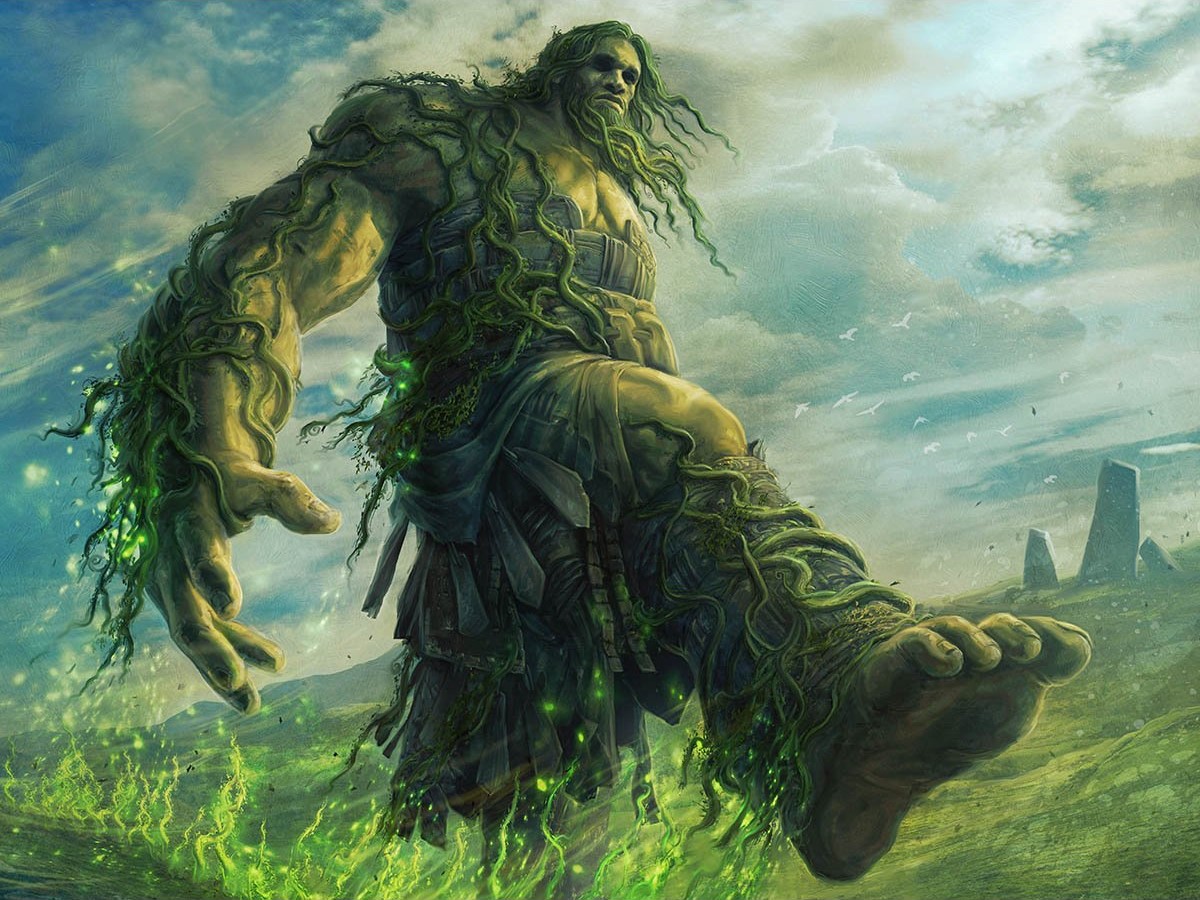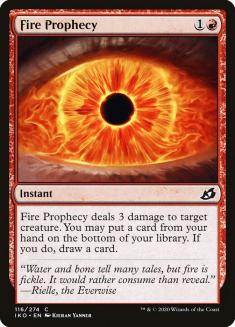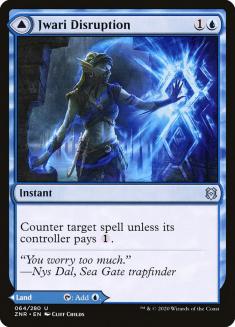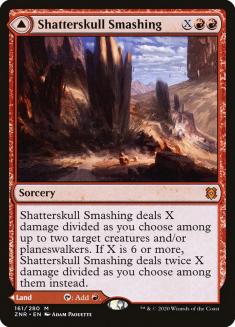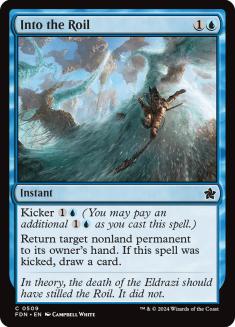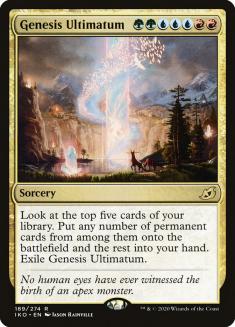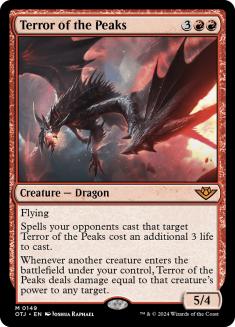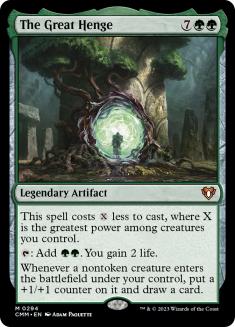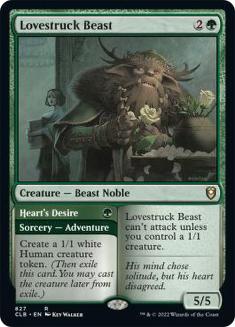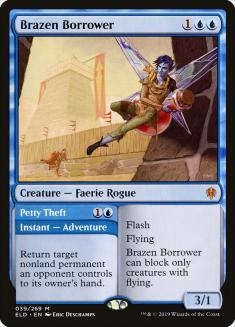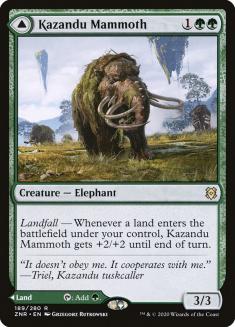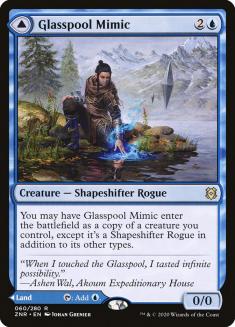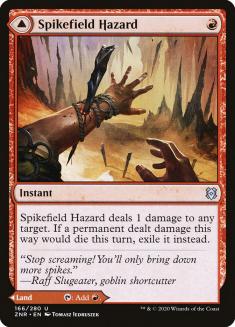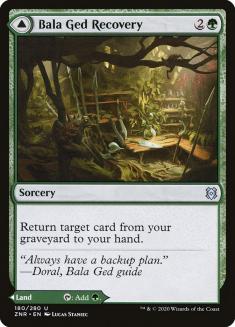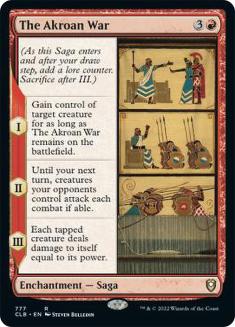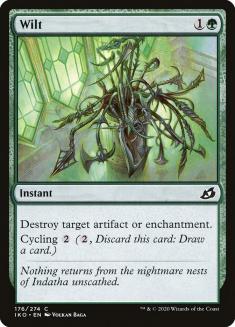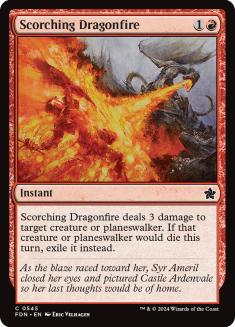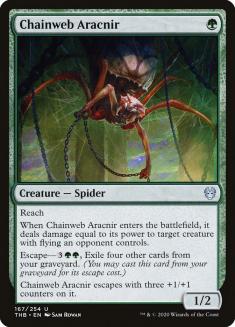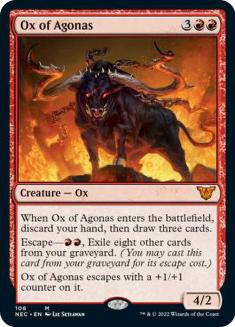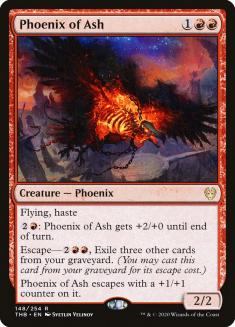If you played Standard in the past eighteen months, you should have played ramp. From Turn 3 Nissa, Who Shakes the World via Llanowar Elves through Growth Spiral and Fires of Invention to Lotus Cobra and Omnath, Locus of Creation, laughing off the usual constraints on mana generation was an easy way to print money and glory.
Those days may finally be over. This reboot of Zendikar Rising Standard has featured various candidates for the ‘best deck’ and the shape of the format has changed so often that, at any point, the metagame from weeks before is unrecognizable. Despite that, one of the few constants has been the looming threat of yet another ramp deck poised to prey on an unprepared format.
The October Zendikar Rising League Weekend — when Azorius Blink (Yorion) was the talk of the town and Rei Sato blindsided the competition with Gruul Adventures — saw Autumn Burchett and Ken Yukuhiro register Temur Ramp lists that were very different from both the format at large and each other:
Creatures (25)
- 4 Lotus Cobra
- 4 Beanstalk Giant
- 4 Bonecrusher Giant
- 4 Llanowar Visionary
- 4 Terror of the Peaks
- 2 Glasspool Mimic
- 3 Kazandu Mammoth
Planeswalkers (2)
Lands (22)
Spells (11)

Creatures (10)
Planeswalkers (4)
Lands (25)
Spells (21)
- 4 Cultivate
- 2 Scorching Dragonfire
- 4 Wolfwillow Haven
- 3 Shark Typhoon
- 4 Genesis Ultimatum
- 2 Bala Ged Recovery
- 1 Spikefield Hazard
- 1 Sea Gate Restoration
Sideboard

Burchett and Yukuhiro identified the same weakness in the format and agreed on the big-picture approach to attacking it. With other decks focused on contesting individual, high-impact permanents with cards like Skyclave Apparition and Elspeth Conquers Death, Temur Ramp could win that battle singlehandedly with Ugin, the Spirit Dragon or dodge it by flooding the battlefield (and often winning on the spot) with Genesis Ultimatum.
These lists differ in their plan to drag the game to this point. Yukuhiro opted for Wolfwillow Haven over Lotus Cobra as a less powerful but less vulnerable two-drop and embraced Shark Typhoon as a scalable threat that can be cashed in for a new card when you lack resources and lines up well against the typical trumps to ramp’s expensive spells. Maindeck Scorching Dragonfire gave him removal for Ruin Crab or Soaring Thought-Thief out of Dimir Rogues — the most popular deck and a tough matchup — that stops recursion via Lurrus of the Dream-Den or Agadeem’s Awakening. Yukuhiro ran the full four copies of Ugin as the ideal (and only) payoff for Genesis Ultimatum in a list that lacks other true payoffs to find.
Burchett’s version is far more creature-heavy to enable Terror of the Peaks — referred to in their excellent piece as ‘the glue that holds the whole deck together’ — which in turn can make even an ‘average’ Genesis Ultimatum immediately lethal. Lotus Cobra and Llanowar Visionary make this list worse at ramping against creature removal but Terror of the Peaks encourages playing more creatures (not just for its triggers but to overload the removal earmarked for your Dragon) while giving you a threat that can still be cast reliably without ramping. Ugin is not the primary plan here but rather an inevitability that promises to define any game that goes on long enough.
For the November Zendikar Rising League Weekend, the MPL and Rivals League fields were littered with players hoping to emulate Rei Sato’s success with Gruul Adventures. Shintaro Ishimura racked up the most wins of anyone on the weekend with his own take on Temur Ramp clearly built with Gruul Adventures in mind:
Creatures (4)
Planeswalkers (4)
Lands (23)
Spells (29)

The most eye-catching feature of Ishimura’s list is the emphasis on Fire Prophecy over Bonecrusher Giant. Giant’s ability to kill a smaller creature and trade with a larger one as part of a smooth curve has made it a tough litmus test for aggro decks since the release of Throne of Eldraine but Prophecy is guaranteed to kill an opposing Giant or Kazandu Mammoth, crucially stopping their contribution to casting Embercleave or The Great Henge. In a deck that cares about both card quality and card quantity, Prophecy allows Ishimura to trade in a redundant ramp payoff for cards that prolong the game until the first one or help an action-light hand fix that problem.
Jwari Disruption highlights the importance of the DFCs to ramp decks, offering all-important land drops as well as flood mitigation. An expensive Force Spike is underwhelming against the low-curve aggressive decks of past Standard formats but Gruul Adventures aims to use all its mana every turn to cast a single, large threat — the possibility of Jwari Disruption forces a tough choice between playing into it and playing into its owner’s hands by staggering your development to avoid it. If you think Temur Ramp is a strong choice for a tournament, this additional tax on opposing Genesis Ultimatums and the like is a good way to get an edge in the mirror. Notably, Jwari Ruins being a blue source also helps an otherwise mostly-Gruul deck handle the blue-heavy cost of your own Ultimatums.
At the other end of the spectrum, Shatterskull Smashing can be the additional land that makes a hand keepable as well as the ideal way to clean up the battlefield in the mid-game or clear the way for a huge Beanstalk Giant to deal the finishing blow.
This awareness of Gruul Adventures’s single-file parade of threats makes bounce effects like Into the Roil or Petty Theft more appealing. Two mana to bounce a Fervent Champion is a bad deal; two mana to banish an Embercleave target or strand a Lovestruck Beast by axing its token is a bargain. Esper Doom Foretold, the most popular foil for Gruul Adventures, deploys its threats in a weirdly similar fashion — if I spend my turn casting Doom Foretold and you passed the turn to hold up a kicked Into the Roil for it, the game has moved further towards a phase that favours the ramp deck with the best end-game in the format.
Despite these players’ success, no one variation of Temur Ramp has enjoyed lasting popularity. As the format changes, these deckbuilding choices must too; luckily, there are more than enough tools under the Temur Ramp banner to find the right shell for the moment. A rather strange twist on Temur Ramp, completely unlike the others, has risen up to demand recognition.
Creatures (28)
- 4 Lovestruck Beast
- 4 Beanstalk Giant
- 4 Edgewall Innkeeper
- 4 Bonecrusher Giant
- 4 Brazen Borrower
- 4 Terror of the Peaks
- 4 Kazandu Mammoth
Lands (23)
Spells (9)

Creatures (24)
- 4 Lovestruck Beast
- 4 Beanstalk Giant
- 4 Edgewall Innkeeper
- 4 Bonecrusher Giant
- 4 Brazen Borrower
- 4 Terror of the Peaks
Lands (26)
Spells (13)

You can’t even mention Temur Adventures (Obosh) without noticing something odd — the companion. Obosh, the Preypiercer has seen marginal play compared to its siblings, almost exclusively in aggressive decks. How is it now propelling ramp to new heights and why does this total package work so well?
While Terror of the Peaks isn’t the glue it was for Burchett’s build, it shines here thanks to Lovestruck Beast. It’s easy to manually shoot down the opponent’s whole team and a combination of Genesis Ultimatum hits that includes Terror and Beast is probably good enough. Beast teams up with Kazandu Mammoth as always to enable The Great Henge — not the core engine piece it is in Mono-Green Food but another cheap-ish ramp payoff that creates strong Ultimatum sequences in the same way as Terror. With our companion shutting off Ugin, maximizing our remaining payoff in Genesis Ultimatum is a top priority.
The Adventure mechanic mitigates the warping effect that Obosh has on your curve. Instead of scraping the barrel for reasonable one-drops to have enough early plays, Adventure creatures give you virtual one-drops and two-drops with the right sticker price for Obosh. This crew isn’t so motley, either — they all boast fine stats for their cost, making Obosh’s damage doubling that much more potent. Brazen Borrower is infamous for stealing games when backed up by other pressure and that’s easier still as a six-power attacker thanks to Obosh. A Kazandu Mammoth backed by Obosh and pumped by landfall is impossible to block well and likely lethal if it connects, to say nothing of Beanstalk Giant. Note that the Stomp half of Bonecrusher Giant still has an even converted mana cost and misses this upgrade.
This in-built pressure makes Temur Adventures (Obosh) harder to sideboard for and play against than a dedicated ramp deck. You have to keep in some removal but all of its targets leave something behind or punish you for using it — you need to kill that Bonecrusher Giant or Terror of the Peaks, but the damage it deals on the way out helps a Brazen Borrower to finish you off instead. You have to hit Edgewall Innkeeper but even the cheapest removal only does that at parity. A hand bogged down with removal is less able to apply pressure or interact in other ways and gives Adventures time to build towards a Genesis Ultimatum.
The reactive cards necessary to stop Ultimatum line up horrendously against an early Edgewall Innkeeper, and Adventures is better at leveraging its own conditional interaction like Mystical Dispute because it can use it alongside cheap creatures to push an aggro-control plan as required or force the opponent to offer up a good target at an awkward time. You can also sidestep this whole question by moving away from the ramp payoffs and becoming a midrange deck after sideboard.
The modality of the Adventure creatures gives you rewards for ramp that go beyond Fertile Footsteps naturally building towards its other half in Beanstalk Giant — you’re likely to have enough extra mana for Heart’s Desire if not Lovestruck Beast or to justify using mana on something because you can also hold up Petty Theft or Stomp. A hand that has ramp but no payoff is better now, as it knows it will eventually have Obosh as a failsafe.
This flexibility extends to the rest of the deck. Even with Obosh’s strict demands, you can take your pick of DFCs that fill different roles. Kazandu Mammoth bolsters the creature plan and enables The Great Henge; Glasspool Mimic is excellent with Terror of the Peaks. Spikefield Hazard doesn’t need to wrangle Lotus Cobra any more but Edgewall Innkeeper, Tangled Florahedron, Thieves’ Guild Enforcer, and Brazen Borrower are all important targets, Borrower more so now that it’s back in vogue in Dimir Rogues and enabling Zareth San, the Trickster.
The result is a deck where every card generates more cards and/or has several options for what it can do. This is a proven recipe for a strong deck but it’s also an endorsement for specifically Obosh as a companion. As Sam Black argued in a broader piece challenging the traditional idea of card advantage, Obosh’s immediate and extreme damage output is especially well-suited to an environment where both players rarely run out of resources. The companion rule change affects that dynamic in a way that harms Obosh in particular — you can no longer suddenly pivot to aggression in the mid-game — but the point stands.
The glaring omission in this list is the main tradeoff forced on us by our companion. Ugin, the Spirit Dragon is the best end-game in Zendikar Rising Standard and decks that aren’t obvious homes for it — Mono-Green Food and Dimir Control (Yorion) — are increasingly building around it.
Despite that, I think it’s actually less crucial here than its ubiquity in other Temur Adventures lists would suggest. As the format’s main archetypes take a more aggressive stance — Gruul Adventures adopting Questing Beast to race ramp decks and prey on Esper Doom Foretold, for example — Ugin is less likely to resolve and to be good enough if it does.
The move back towards Brazen Borrower and Zareth San in Dimir Rogues is especially dangerous as Ugin is the best possible card to turn against its owner. Meanwhile, the focus on Terror of the Peaks and Genesis Ultimatum with backdoor Obosh wins gives Temur Adventures (Obosh) the best end-game in Zendikar Rising Standard without Magic’s most ineffable Dragon.
Of course, if Ugin (or any other card with an even converted mana cost) is important enough, you can always sideboard it in and accept that you are giving up Obosh when you do:
The Akroan War’s power in green midrange mirrors is well-documented and may be worth making that sacrifice. Wilt has overperformed for me in Gruul Adventures and Mono-Green Food partly as a cheap way to break serve against The Akroan War as well as Embercleave and The Great Henge. The two-mana removal that was so integral to the lists above is more replaceable, and the conveniently odd Soul Sear is often an upgrade as it kills Lovestruck Beast to preempt The Great Henge or Wicked Wolf against Mono-Green Food.
Keeping up with developments elsewhere in the format is vital for a deck this customizable. Chainweb Aracnir was the go-to escape creature for green decks when Dimir Rogues first disappeared on the scene but its strength was heavily dependent on the exact sub-genre of Dimir Rogues on the other side. A list full of Merfolk Windrobbers and relying more on combat could easily be stuck in the Spider’s web; the adoption of Ruin Crab and Lurrus of the Dream-Den allowed other Dimir Rogues lists to push their plan without caring about combat.
These lists were a tough but tenable matchup for Autumn’s build, which struggled more against the controlling Dimir Rogues decks featuring Shark Typhoon and more interaction that Luis Scott-Vargas brought to that League Weekend. Ox of Agonas soon became the default escape creature for Gruul Adventures or any Temur deck as it was both cheaper and more reliably useful against the various Dimir Rogues lists you might face.
Now, with Brazen Borrower and Zareth San back in favour, Chainweb Aracnir has more strong targets and its ability to block well is more relevant than ever. Ox of Agonas may well be better regardless but understanding these dynamics helps you make informed card choices.
Temur Adventures (Obosh) is unlikely to be Temur Ramp’s final form in this ever-moving Standard. As it becomes more and more popular, trying to beat it at its own game with a dedicated ramp strategy sounds appealing and some of the game’s top players have given us the template to do just that. Until then, this iteration is a highly adaptable weapon that competes well at every stage of the game and rewards those who put the time in to master it.
As we settle in for a long, cold winter before Kaldheim, take your chance to get some reps in!

